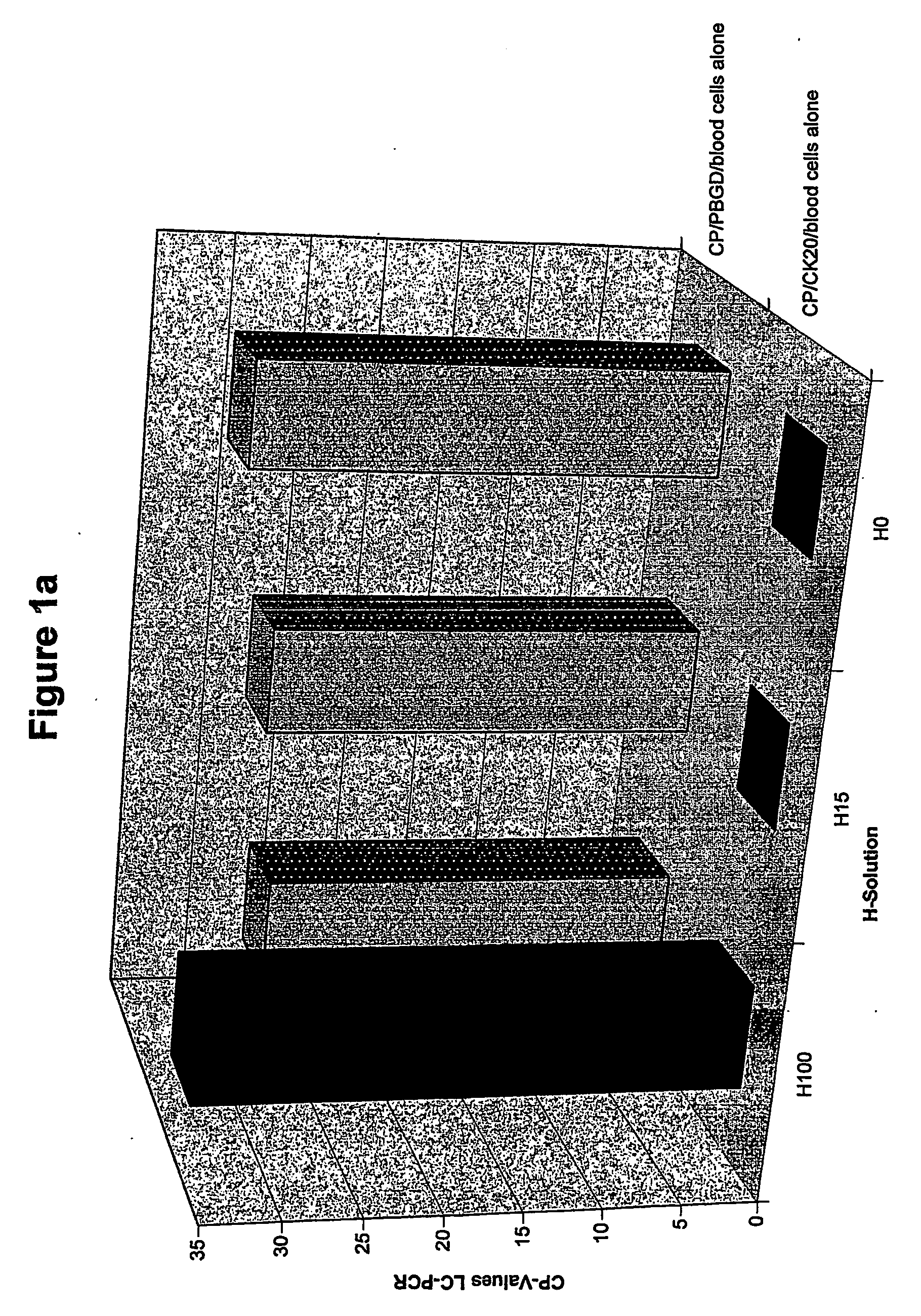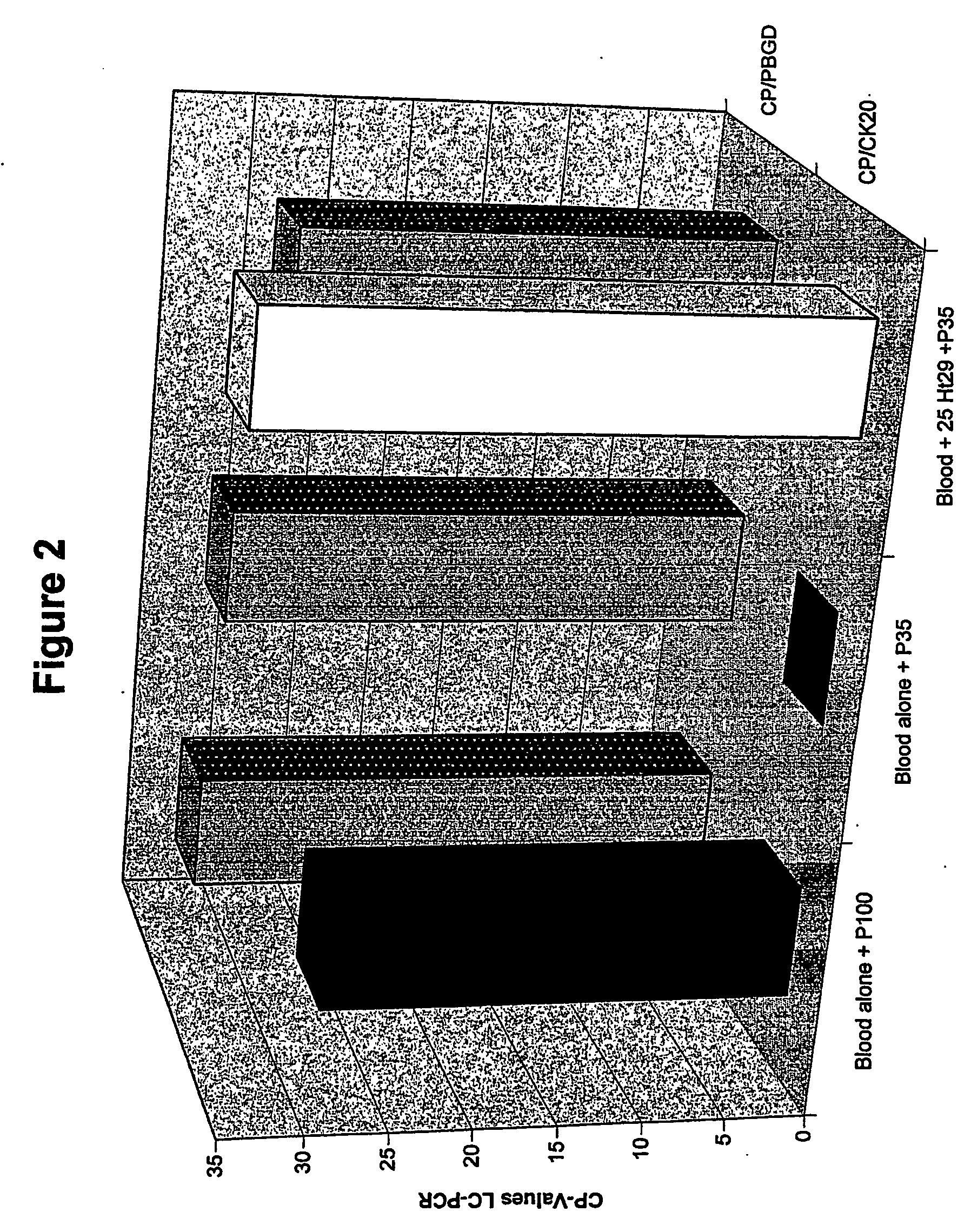Method for the separation of cell fractions
- Summary
- Abstract
- Description
- Claims
- Application Information
AI Technical Summary
Benefits of technology
Problems solved by technology
Method used
Image
Examples
example 1
[0116] Blood was taken from a blood donor and divided into 2 aliquots. The first aliquot was treated on its own and for the second aliquot after addition of 1000 HT29 tumor cells. Since only 20% of the cDNA generated can be used for the CK-20 PCR, the signals correspond to those for 200 HT29 cells. The samples were treated and analyzed in the same manner as the reference example.
[0117]FIG. 1a shows the results for the test run without addition of tumor cells. CK20 and PBGD signals are detected for the blood cells treated with a solution of 276 mosmoles (H100). No CK20 signal is seen after treatment with H solutions (H15-HO) with a lower osmolality (<46 mosm / kg), but the PBGD signal is present (sufficient sample material was therefore present).
[0118]FIG. 1b shows the results for the test run with tumor cells added (HT29). CK20 and PBGD signals are also detected after treatment of the sample with solutions of low and very low osmolality (H15, HO). Since no CK20 signal was seen in th...
example 2
[0125] Blood was taken from a blood donor and split into 2 aliquots. The first aliquot was used without addition of tumor cells the second aliquot was mixed with 25 HT29 tumor cells.
[0126] The samples were prepared and analyzed in the same manner as the reference example.
[0127] Since only 20% of the cDNA generated can be used for the CK-20 PCR, the s signals correspond to those for 5 HT29 cells. For this donor, the background signal was reached with hypotonic solutions at an osmolality of just 103 mosm / kg.
[0128]FIG. 2 shows the results of quantitative RT-PCR for CK20 and PBGD. The CK20 and PBGD signals can be detected without treatment of the blood cells with hypotonic solutions (blood alone). Incubation with a P35 solution (103 mosm / kg) leads to elimination of the CK20 signal. The PBGD signal is retained (with P35). In the parallel run, containing 25 HT29 tumor cells, the CK20 signal remains detectable (blood+25Ht29+P35).
example 3
Improvement of the Results of Lysis Through Addition of RNase A
[0129] Example 1 was repeated. RNase A (1 mg / aliquot) was added to the blood before treatment with the P / H solution to enable rapid degradation of the RNA before the final lysis through the RLT buffer containing guanidinium isothiocyanate. This led to an improvement in the results of lysis, i.e., lysis was also possible with solutions of higher osmolality.
PUM
| Property | Measurement | Unit |
|---|---|---|
| Weight | aaaaa | aaaaa |
| Weight | aaaaa | aaaaa |
| Weight | aaaaa | aaaaa |
Abstract
Description
Claims
Application Information
 Login to View More
Login to View More - R&D
- Intellectual Property
- Life Sciences
- Materials
- Tech Scout
- Unparalleled Data Quality
- Higher Quality Content
- 60% Fewer Hallucinations
Browse by: Latest US Patents, China's latest patents, Technical Efficacy Thesaurus, Application Domain, Technology Topic, Popular Technical Reports.
© 2025 PatSnap. All rights reserved.Legal|Privacy policy|Modern Slavery Act Transparency Statement|Sitemap|About US| Contact US: help@patsnap.com



